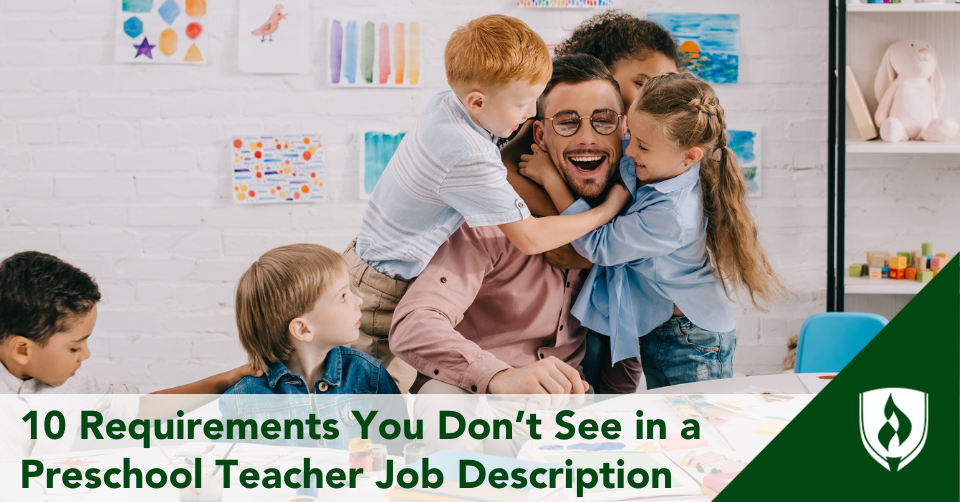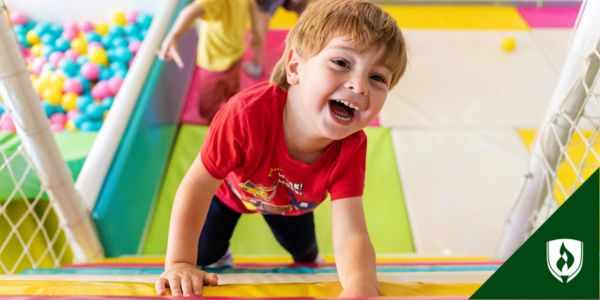10 Requirements You Don't See in the Preschool Teacher Job Description
By Hope Rothenberg on 01/04/2024

You’re caring, you love kids and you’re passionate about early childhood education (ECE). You want to become a preschool teacher, but you’re not sure what education or training preschool teachers actually need.
You have a general idea of what preschool teachers do, and there are job descriptions online. But you also know there has to be more to it; standard descriptions don’t convey how much a preschool educator truly takes on.
The good news is that even though the job typically requires more than what's on paper, you’ll likely enjoy the added responsibilities if you’re passionate about the work. The best thing you can do is be prepared—and that starts with locking down the basics.
Navigating the education requirements for preschool teachers1
There’s a lot of variation in preschool teacher jobs, and that extends all the way to the requirements you have to fulfill to even get started.
The education and training requirements for becoming a preschool teacher vary by state and school.
Some may require a high school diploma, some may require an associate's degree or bachelor's degree, some may require prior preschool classroom experience as an intern or assistant and some may require a state test for preschool teacher certification.2
The education and licensing requirements also change depending on if you want to work in a private or public preschool. Check all requirements for the preschool setting that you wish to work in.”²
For example, a public preschool setting might require a teacher’s license. But if you teach preschool in a private school, daycare or ECE school, you may not need a teaching license.
The Early Childhood Education programs at Rasmussen University are not designed to meet, and do not meet, the educational requirements for licensure to teach in public preschools¹ Instead, they prepare you for work in non-public-school settings.
It’s important to look into those details and consider the work environment you want before you enroll in a program to become a preschool teacher.
(For more detail on the nuances between different types of ECE programs, check out 10 Reasons to Pursue Your Early Childhood Education Degree Online at Rasmussen.)
10 job requirements you don’t see in a preschool teacher job description
A typical preschool teacher job description explains a preschool teacher as being responsible for teaching younger children learning skills, ensuring their safety during school hours and keeping order within the classroom. It’ll usually list responsibilities like the following: teaching basic skills from personal hygiene to shapes and colors, establishing rules and procedures to promote positive classroom behaviors and leading different games and activities.2
You probably already know that barely scratches the surface. Preschool teachers do a lot more than this. Once you’ve got the written requirements and expectations down, you can start preparing for the unwritten ones. Here are 10 unwritten preschool teacher requirements to be aware of as you prepare to enter the field.
Preschool teachers need to…
1. Be organized
Children are unpredictable, so every day as a preschool teacher looks a bit different. Balance out the unexpected by creating and sticking to a classroom routine—whether that’s as simple as keeping reading and nap time the same every day or coming up with a full hour-by-hour schedule.
Maintaining classroom order often requires having all the materials you may need on-hand ahead of time. From tissues for runny noses to towels for spills and band aids for scrapes, being proactive about obtaining the right supplies (and having a handy place for all of them) is essential to your success.
2. Be inclusive
In our diverse world, it’s important to ensure that every child feels seen and included. Make sure your curriculum reflects the cultures, communities and everyday experiences of all the students in your class. Acknowledge the similarities and differences between your students and celebrate them—recognizing the value of diversity in every form.
Be inclusive of differences in culture, language, gender, ability, religion, race, economic class and family structures, and help children learn to do the same. Including the identities and lived experiences of your students across your learning materials and classroom environment is a huge responsibility, and one that very well may not be listed in the job description.2
3. Be curious
Part of being inclusive is being curious. Take time to learn about the children and families you work with, and use that to inform your learning environment. From the languages they speak at home to who their caregivers are, the more you know about your students the more responsive you can be.
This may require you to spend extra time reaching out to families that don’t attend open houses or parent–teacher conferences. While it’s not a baseline requirement of the job, curiosity can be the best way to understand more about your students and their unique situations.3
4. Be observant
Being curious and being observant are often two sides of the same coin. In addition to actively asking questions, sometimes it’s wise to take a step back and see what you notice. After all, observation is a teacher's best tool, according to NAEYC®.
Through observing your students, you can learn what they’re capable of, how they approach solving problems, how they spend their time, how they interact with others and what they're learning. Keeping track of each student's child development can help you decide whether to modify the curriculum or classroom environment to better meet their needs.4
5. Be creative
Every child learns differently and expresses themselves differently. Thinking outside the box and using different teaching methods to help children more easily grasp material is important.
Try out new ideas, be open-minded, be adaptive and experiment and explore right alongside your students. You don’t have be an artist or musician to teach children, but you do have to get creative to help your students reach their goals—and make the experience fun and enjoyable in the process.
6. Be collaborative
We’ve all heard the phrase, “it takes a village", and it’s no less true in the preschool classroom. Preschool teachers work with a range of individuals on a day-to-day basis. In addition to working with your students’ caregivers and families, be open to collaborating with a teaching assistant, child development associate, early childhood special educator, health professional and any other professional that may prove helpful.
Establishing and fostering relationships that build community and strengthen support systems for your students is invaluable. Going out of your way to do this can make a big impact as they continue on in their educational journeys.
7. Be nurturing
Preschoolers are typically around three to five years old—and it can be easy to forget just how young that really is. Developing trusting, nurturing relationships with children is extremely important, and it’s just as much a part of being a good preschool teacher as planning lessons and hitting milestones.
If the purpose of preschool is to prepare students for kindergarten, teaching young children the value of a positive student-teacher relationship and creating a nurturing classroom environment is essential—and that may require more effort than what's written on paper.
8. Be humorous
Young kids are silly. You should take your job seriously, but you should also enjoy the fun parts. When your students do something funny, laugh with them. Enjoy silly games, songs, dances and rhymes—and remember that understanding and engaging with humor is a part of the learning experience, too.
If you can maintain your humor while managing your class, the more enjoyable of a space the classroom will be, and the more fun you’ll have as you teach.
9. Be patient
You’ve probably seen “patience” listed on job postings for a few different preschool programs. But what does that really mean, and what does it entail? Being patient with young children and their behavior is one thing. But being patient with a new program, school system and group of parents is another.
Taking the time to get familiar with your new role and adjusting to your newfound responsibilities is important, and having grace with yourself and those around you may be what allows you to succeed in the long run.
10. Be self-aware—and be yourself
When it comes to putting all this into practice, recognize how your own personal biases and perspective may influence the way you observe and assess your students’ development. The more self-aware you are, the more you can remain objective and ensure you treat every child as fairly and respectfully as possible.
Though being mindful of where you come from and the way you approach teaching is important, it doesn’t mean you can’t be yourself.
Show your students your personality, let them get to know you and connect with them on a personal level. By doing this, you can model what a positive relationship looks like—and give them the opportunity to build one with one of the first educators they’ll have in their academic lives.
Is the work worthwhile?
As you can see, preschool teachers take on a lot of responsibility. These formative years are so essential to help children thrive, and preschool teachers are right at the helm of that formation.
There’s no question that a good preschool teacher is worth their weight in gold to the children, families and society in general—but the role isn’t a good fit for everyone. Preschool teachers need to be so patient, so strong and so committed to children. Is that you?
If you suspect it might be, check out Why Become a Teacher? Preschool Educators Share What They Love About Their Work.
Related Articles:
NAEYC® is a registered trademark of National Association for the Education of Young Children
1The Early Childhood Education programs at Rasmussen University are not designed to meet, and do not meet, the educational requirements for licensure to teach in public preschools, or kindergarten, elementary, or secondary schools in any state. A bachelor’s degree from a state-approved university or university and a state teaching license are typically required to work as a teacher in a public school, and in private school settings. The Rasmussen University Early Childhood programs are not approved by any state agency that licenses teachers. States, municipalities, districts, or individual schools may have more stringent licensure requirements and other standards. Childcare facilities and the states in which they are located establish qualifications for staff that work with children, and often implement guidelines regarding age, education experience, background, and professional development. Before enrolling, it is important to understand all of the licensure eligibility standards for a desired career by consulting the appropriate state and school/facility requirements.
2Teachers of Tomorrow, How to Become a Preschool Teacher in 2023 [Accessed November 2023] https://www.teachersoftomorrow.org/blog/insights/how-to-become-a-preschool-teacher-in-2023/
3NAEYC, Recommendations for Early Childhood Educators [Accessed November 2023] https://www.naeyc.org/resources/position-statements/equity/recommendations-ECE
4NAEYC, Advice for a New Preschool Teacher [Accessed November 2023] https://www.naeyc.org/resources/blog/advice-new-preschool-teacher




